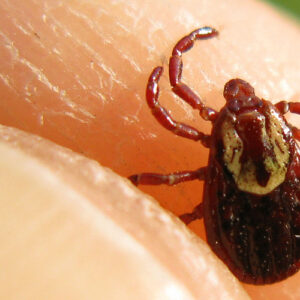
Local Ticks: Nuisance or Risk?
Ticks are a frequent source of conversation and irritation during summer months in the Inland Northwest. In Washington state, ticks carry few diseases and reported cases are few, as compared to other states. In the Spokane-area, only three tick-borne diseases are rarely locally-acquired: tickborne relapsing fever, tularemia, and tick paralysis. However, other diseases are noted.
Lyme Disease
Lyme disease is the most common tick-borne disease in the United States (US) but is rare in Washington. It is caused by the bite of an infected Ixodes tick that transmits bacterium of the Borrelia type, with B. burgdorferi most common in the US. Fewer than three Washington-acquired cases are reported yearly, almost always west of the Cascades. The pathognomonic sign of infection is the rash, erythema migrans (EM), that occurs at the site of inoculation in 70-80% of individuals. It is recognized by its target-shape or “bull’s-eye” appearance. Additional symptoms include fever, headache, myalgias and arthralgias. Disseminated infection occurs if treatment is lacking, progressing to persistent constitutional, rheumatologic, neurologic and cardiac symptoms and disease. Testing for Lyme disease is complicated, especially in low prevalence populations such as that found in the Spokane region.
Rocky Mountain Spotted Fever
Each year fewer than three cases are identified, some acquired in-state and others elsewhere. The bacterium that cause Rocky Mountain Spotted Fever (RMSF), Rickettsia rickettsii, is transmitted by the bite of an infected Rocky Mountain wood tick, Dermacentor andersoni, or an American dog tick, D. variabilis. These ticks are found throughout the state and common in eastern Washington, but RMSF is rare locally. A poorly named illness, most cases of RMSF are acquired and diagnosed in the southeastern US. RMSF has the highest mortality of the tick-borne infections, with a rate of 20-25% in untreated individuals. Initial symptoms are non-specific and include fever, severe headache, diffuse arthralgias and severe myalgias, fatigue, and gastrointestinal symptoms (Abdominal pain, nausea and diarrhea). The characteristic vasculitic maculopapular rash appears in less than 50% of infections within the first three days of disease, but is present in 90% of individuals within 2-6 days; the classic presentation on the palms and soles is usually present by the fifth day. Because of its high mortality, diagnosis and treatment is often empirically based upon a suggestive history and physical exam, with confirmation established subsequently. Treatment is most successful when antibiotics are prescribed within five days of symptom onset.
Anaplasmosis
To date, no locally exposed Washington cases of anaplasmosis have been reported, but very low levels of the bacterium that causes anaplasmosis, A. phagocytophilum, have been found in Ixodes ticks collected from the state. Signs and symptoms begin within 1-2 weeks after exposure and can include fever, headache, muscle pain, and fatigue.
Babesiosis
Another rare disease in Washington, less than 15 cases have been identified since 1990 with most acquired out of state. Ixodes pacificus, found primarily in western Washington, is considered the vector of this disease. Infection is caused by a parasite of the genus Babesia. Symptoms of babesiosis may include fever, chills, fatigue, muscle pain, and hemolytic anemia, although many infected individuals are asymptomatic.
Tick-Borne Relapsing Fever
One to 12 cases of tick-borne relapsing fever are reported each year in Washington. The soft tick, Ornithodoros hermsi, typically feeds on rodents, picking up the Borrelia hermsii bacteria. The infected tick can then transmit the bacteria by feeding on a human for a short period of time. Since these ticks are associated with rodent burrows and nests, it is important to keep rodents out of sleeping areas. Symptoms include relapsing periods of high fever lasting for 2-7 days, disappearing for about 4-14 days, and then reoccurring, headache, and myalgias and arthralgias. Left untreated, infected individuals will experience several episodes of recurrent fevers before resolution.
Tick Paralysis
This is the only tick-borne illness to not be caused by an infectious agent. Rather, it occurs as a result of a neurotoxin injected by an attached tick while feeding. Children are most often infected, with the bites commonly occurring on the scalp and hairline. Washington receives 0-2 reports per year with exposures mostly in eastern Washington. Symptoms usually begin within a few days of attachment, and begin with fatigue and lower extremity numbness and muscle pain. Progressive ascending paralysis subsequently develops within 4-7 days of tick feeding. While removal of the tick causes resolution, its lack may lead to respiratory failure and death.
Tularemia
This is a disease caused by the bacterium Francisella tularensis. Annually, 1-10 reports occur in Washington. It occurs both humans and animals. As such, transmission may occur through tick bites, as well as contaminated water, skin exposure to rabbits, hares and other rodents, and inhalation while farming or landscaping, especially with machinery. Symptoms reflect the route of transmission. All forms experience fevers. Ulceroglandular (Bite or skin contact) is the most common form, with a localized ulcer at the site and regional adenopathy. A glandular form also exists that is caused by the same method of transmission. Other forms produce ocular symptoms (Oculoglandular), sore throat and adenopathy (Oropharyngeal) or abdominal pain, anorexia and diarrhea (Intestinal). The pneumonic form is the most serious, caused by inhalation, while a typhoidal form presents as generalized symptoms without localization.
Tick Testing
While neither the Washington State Public Health Laboratory (PHL) nor the Centers for Disease Control and Prevention (CDC) tests ticks for disease, PHL staff can identify tick species. Because different tick species transmit different pathogens, knowing the tick species may be helpful in diagnosis.
When considering a possible human tick-borne disease, healthcare providers (HCPs) can submit ticks for speciation along with the Microbiology Submission Form. The request should be marked "Parasitology" and indicate tick exposure location in "Comments.” Note that this is only for speciation, not testing the tick for diseases. An individual who finds a tick on her/himself or a pet can submit the tick for identification along with the Tick Identification Submission Form.
Additional Resources
